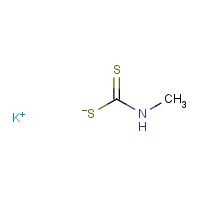Metam-potassium
Agent Name
Metam-potassium
Alternative Name
Potassium N-methyldithiocarbamate
CAS Number
137-41-7
Formula
C2-H5-N-S2.K
Major Category
Pesticides

Synonyms
Potassium N-methyldithiocarbamate; Carbamic acid, N-methyldithio-, potassium salt; Carbamic acid, methyldithio-, monopotassium salt; Carbamodithioic acid, methyl-, monopotassium salt; Metam potassium; Monopotassium methylcarbamodithioate; Monopotassium methyldithiocarbamate; [ChemIDplus]
Category
Dithiocarbamates (Pesticide)
Description
Concentrated aqueous solution: Clear orange liquid with a pungent odor of rotten eggs; [CAMEO]
Sources/Uses
Has activity as fungicide, herbicide, and nematicide; [Compendium of Pesticide Common Names] Used as non-selective soil fumigant that possesses fungicidal, herbicidal, insecticidal, and nematicidal properties; Approved for use on food, feed, and fiber crops, turf grass, and drained ponds and lakes (California only); Also used as antimicrobial agent for wood poles, pulp and paper, leather processing, sugar cane and beet processing, metalworking cutting fluids, petroleum operations, coatings (protective colloids, emulsion resins, and water-thinned paints), and industrial water cooling and purification; [Reference #1]
Comments
Rapidly degraded in the environment forming methyl isothiocyanate (MITC), which is the volatile active fumigant; Metabolites include MITC and carbon disulfide; May cause skin sensitization; [Reference #1] Several of the dialkyldithiocarbamates are known skin sensitizers; See "Carba mix." See "Metam-sodium."
Reference Link #1
Biomedical References
Adverse Effects
Skin Sensitizer
Yes
Diseases, Processes, and Activities Linked to This Agent
Diseases
Occupational diseases associated with exposure to this agent:
Processes
Industrial Processes with risk of exposure: